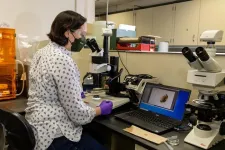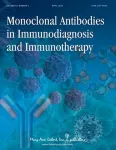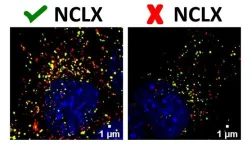(Press-News.org) George Mason University researchers have received a $1,176,645 grant in federal funding from the U.S. Department of the Army to revolutionize Lyme disease detection and diagnosis with urine testing. The College of Science and College of Public Health aim to harness the many advantages of urine testing over other methods and increase mainstream adoption.
“We have developed a urine test for Lyme disease that detects the bacteria (Borrelia species) that causes Lyme disease, making it a direct test to confirm an infection soon after the tick bite. This leads to earlier treatment when necessary and could prevent the long-term debilitating effects of the disease,” said Alessandra Luchini, systems biology professor in the College of Science and Mason’s principal investigator.
The current standard of care test for potential Lyme disease is an antibody blood test which measures the immune system response to the bacteria that cause Lyme disease. In contrast, the Mason test detects molecules derived from the bacteria themselves, which have the advantage of high specificity (accuracy) and early detection. The Mason test matches the exact amino acid sequences (the building blocks of the bacterial molecules) that are found only in Borrelia and not in other organisms. For example, one of the proteins the Mason scientists studied is part of the Borrelia flagellum, which allows the bacterium to move around the body.
In Mason’s clinical research trials, urine tests had a 90% true positive rate (sensitivity) and close to 100% specificity (true negative rate). Researchers will use banked samples from cross-sectional and longitudinal studies of acute Lyme patients from the Lyme Disease Biobank and banked specimens from Johns Hopkins University, respectively, who are recognized leader in clinical Lyme disease research.
Utilizing her 15 years of Lyme disease bacteria (Borrelia) research, Ashley Groshong, PhD, unit chief of the Bacterial Physiology and Metabolism Section of the National Institute of Allergy and Infectious Diseases, a part of the National Institutes of Health, is collaborating on the project by evaluating the suitability of diagnostic indicators based on bacterial physiology.
Additionally, the Mason study will pilot a collapsible urine collection cup shipped to a lab through the mail, making collection and diagnosis easier for more people to access through telehealth.
"A urine cup will offer a private, comfortable and convenient way to collect the sample at home without compromising the accuracy of the lab test,” said Lance Liotta, professor in the College of Science, co-director of Mason’s Center for Applied Proteomics and Molecular Medicine, and co-investigator on the study. “Shipped in a semi-dry state that will preserve target proteins and protects again specimen degradation, this approach will improve specificity which has been a weakness of previous testing approaches."
Lyme disease is the most common animal-to-human transmitted disease in the United States with approximately 476,000 people diagnosed and treated each year—and it is on the rise. If not treated quickly and properly, those bitten can suffer from prolonged symptoms (called Post-Treatment Lyme Disease Syndrome), such as concentration and memory issues, dizziness, fatigue, body aches, depression, and difficulty sleeping.
“This is a significant collaboration to advance diagnostics for Lyme disease. In my capacity as an epidemiologist, I am thrilled to work with Drs. Luchini, Liotta, and Espina, and Dr. Krall in her capacity as a biostatistician. This study will have a major impact on the timely diagnosis of Lyme,” said Melissa J. Perry, dean of the College of Public Health and co-investigator of the study.
This three-year study will take place in the same Mason CAP/CLIA Clinical Proteomics Laboratory that implemented the innovative saliva COVID test. The lab is run by Virginia Espina, who is a collaborator on the grant.
This work will be supported by The Assistant Secretary of Defense for Health Affairs through the Tick-Borne Disease Research Program, endorsed by the Department of Defense. Opinions, interpretations, conclusions and recommendations are those of the author and are not necessarily endorsed by the Department of Defense.
About George Mason University
George Mason University is Virginia’s largest public research university. Located near Washington, D.C., Mason enrolls more than 40,000 students from 130 countries and all 50 states. Mason has grown rapidly over the past half-century and is recognized for its innovation and entrepreneurship, remarkable diversity, and commitment to accessibility. In 2023, the university launched Mason Now: Power the Possible, a one-billion-dollar comprehensive campaign to support student success, research, innovation, community, and stewardship. Learn more at gmu.edu.
About the College of Science
Mason’s College of Science is a leader in scientific discovery and a creator of innovative solutions for the rapidly-changing needs of today’s world. The college prides itself in being home to a diverse population of more than 4,200 students and researchers serving as a magnet for all scientific minds. With new discoveries, our scientists continue to grow Mason’s portfolio of patents, licenses, partnerships, and spin off companies.
The college blends traditional science education with sought-after programs at all levels across a dozen departments to challenge and engage in disciplines including personalized medicine, infectious diseases, drug discovery, climate dynamics, environmental justice and conservation, materials science, astronomy, forensic science, computational science, and applied mathematics. Learn more at science.gmu.edu.
About the College of Public Health
Mason’s College of Public Health—the first College of Public Health in Virginia—enrolls more than 1,900 undergraduate and 1,300 graduate students in its nationally recognized programs, including six undergraduate degrees, eight master’s degrees, five doctoral degrees, and six professional certificate programs. Comprising the School of Nursing and the Departments of Global and Community Health, Health Administration and Policy, Nutrition and Food Studies, and Social Work, the college also conducts transdisciplinary research that seeks to understand the many factors that influence the public health and well-being throughout the lifespan. With more than 500 partners, the college serves the community and engages its students through research, practice, and clinical care.
END
George Mason University receives over $1.1 million to revolutionize Lyme disease testing
With tick bites on the rise, College of Science and College of Public Health are collaborating to improve detection, diagnosis, and treatment with urine testing
2024-05-02
ELSE PRESS RELEASES FROM THIS DATE:
NASA selects BAE systems to develop air quality instrument for NOAA
2024-05-02
NASA, on behalf of the National Oceanic and Atmospheric Administration (NOAA), has selected BAE Systems (formerly known as Ball Aerospace & Technologies Corporation) of Boulder, Colorado, to develop an instrument to monitor air quality and provide information about the impact of air pollutants on Earth for NOAA’s Geostationary Extended Observations (GeoXO) satellite program.
This cost-plus-award-fee contract is valued at approximately $365 million. It includes the development of one ...
For microscopic organisms, ocean currents act as 'expressway' to deeper depths, study finds
2024-05-02
PROVIDENCE, R.I. [Brown University] — Some of the ocean’s tiniest organisms get swept into underwater currents that act as a conduit that shuttles them from the sunny surface to deeper, darker depths where they play a huge role in affecting the ocean’s chemistry and ecosystem, according to new research.
Published in the Proceedings of the National Academy of Sciences and based on fieldwork during three research cruises spanning 2017 to 2019, the study focuses on subtropical regions in the Mediterranean Sea. It uncovered how some microscopic single-celled organisms that are too light to ...
Rice’s Harvey, Ramesh named to National Academy of Sciences
2024-05-02
HOUSTON – (May 2, 2024) – Rice University’s Ramamoorthy Ramesh and Frank Reese Harvey are among 120 new U.S. members elected to the National Academy of Sciences (NAS) “in recognition of their distinguished and continuing achievements in original research,” according to a statement from the organization.
Members are elected by their peers based on their contribution to one of six areas of scientific inquiry following an extensive vetting process. Established in 1863 through an act of Congress, NAS serves as a source of independent, objective advice on science ...
Oil palm plantations are driving massive downstream impact to watershed
2024-05-02
AMHERST, Mass. – The global demand for palm oil—the most widely consumed vegetable oil on the planet, in everything from instant noodles to lipstick—is driving worldwide tropical deforestation. While many studies have shown the loss of biodiversity when rainforests are converted to oil palm plantations, researchers at the University of Massachusetts of Amherst are the first to show far-reaching and wide-ranging disturbances to the watersheds in which such plantations occur. Because many Indigenous peoples rely on water downstream from the plantations for their daily needs, the marked decrease in water quality has ...
Nanotubes, nanoparticles, and antibodies detect tiny amounts of fentanyl
2024-05-02
A research team at Pitt led by Alexander Star, a chemistry professor in the Kenneth P. Dietrich School of Arts and Sciences, has developed a fentanyl sensor that is six orders of magnitude more sensitive than any electrochemical sensor for the drug reported in the past five years. The portable sensor can also tell the difference between fentanyl and other opioids.
Their work was published in the journal Small.
Fentanyl is a synthetic opioid and one of the main drivers in overdose deaths in the United States, Star said. It’s often mixed with other drugs, but because ...
New eco-friendly lubricant additives protect turbine equipment, waterways
2024-05-02
Scientists at the Department of Energy’s Oak Ridge National Laboratory have developed lubricant additives that protect both water turbine equipment and the surrounding environment.
Each year, roughly 2.47 billion gallons of lubricating oil are consumed in the United States alone for engines and industrial machinery, according to DOE, with about half eventually finding its way into the environment.
While environmentally acceptable lubricants are available, they are not optimized with additives that can greatly improve performance while posing minimal environmental impact if accidentally released. To create nontoxic, biodegradable and high-performing lubricant ...
Monoclonal Antibodies in Immunodiagnosis and Immunotherapy appoints new Deputy Editor-in-Chief, Andrei Moroz, PhD
2024-05-02
Mary Ann Liebert, Inc., is pleased that Andrei Moroz, PhD, has been appointed the new Deputy Editor-in-Chief of the bimonthly journal Monoclonal Antibodies in Immunodiagnosis and Immunotherapy. Dr. Moroz is joining Cory Brooks, PhD, as part of the senior editorial leadership team for the journal.
Monoclonal Antibodies in Immunodiagnosis and Immunotherapy is a peer-reviewed venue for promoting and sharing research rooted in hybridoma technology. It aims at advancing the understanding of the biology and immunology that underscores the utility of antibodies as diagnostics and therapeutics. The journal publishes ...
Optical pumped magnetometer magnetocardiography as a potential method of therapy monitoring in fulminant myocarditis
2024-05-02
https://www.scienceopen.com/hosted-document?doi=10.15212/CVIA.2024.0031
Announcing a new article publication for Cardiovascular Innovations and Applications journal. Fulminant myocarditis (FM) is associated with high mortality and an unfavorable long-term prognosis. However, noninvasive, rapid diagnostic and monitoring methods for FM are lacking.
This article details the case of a patient diagnosed with FM through a comprehensive assessment involving typical clinical symptoms, laboratory analyses, echocardiographic evidence, and cardiac magnetic resonance (CMR) findings. Before the patient underwent CMR, optical pumped magnetometer magnetocardiography (OPM-MCG) revealed abnormalities characteristic ...
Heart failure registries in Asia – what have we learned?
2024-05-02
https://www.scienceopen.com/hosted-document?doi=10.15212/CVIA.2024.0026
Announcing a new article publication for Cardiovascular Innovations and Applications journal. Heart Failure (HF) is one of the leading problems in cardiology practice today. Acute decompensated heart failure (ADHF) is a significant cause of mortality and morbidity worldwide, and this is more relevant in the Asian subcontinent with a high population burden. Various regional registries in Asia have given us valuable insight into the aetiology and outcomes in this context. Though there are regional differences, it is clear from the review carried out in this paper that HF affects a much younger population. ...
Study helps understand how energy metabolism is regulated at cellular level
2024-05-02
An article published in The Faseb Journal describes a Brazilian study analyzing the correlation between two key energy metabolism regulation processes: the absorption and release of calcium ions by mitochondria, the organelles that generate energy for cells; and autophagy induced by calorie restriction. Autophagy occurs when cells break down and reuse their own cytoplasm.
The study was conducted at the Center for Research on Redox Processes in Biomedicine (Redoxome), a Research, Innovation and Dissemination Center (RIDC) funded by FAPESP and hosted by the University of São Paulo’s Institute of Chemistry ...
LAST 30 PRESS RELEASES:
Sophisticated neuroimaging reveals PTSD in WTC responders is linked to measurable physical changes in brain structure
Health policy experts identify promising strategies for providing health care to homeless people
Study explores role of neutrophils in canine atopic dermatitis
Mayo Clinic researchers develop AI-ECG model to diagnose liver disease earlier
Heavy menstruation common among teenage girls – questionnaire reveals risk of iron deficiency
New study explores why open water swimming feels so powerful for midlife women
In echo of Jurassic Park, mosquitoes capture entire ecosystems in their blood meals
Marty Cooper, Illinois Tech Alumnus and ‘Father of the Cell Phone,’ Receives 2025 Marconi Society Lifetime Achievement Award
How to reduce the risk of lymphedema
NEJM Evidence and CIDRAP announce Public Health Alerts
New fossil study illuminates on the evolutionary success of frogs
Patient-specific human liver model to understand disease mechanisms
Confused by the doctor's questionnaire? U of A study suggests it's common
How do brains stay stable, and when might a dose of flexibility be helpful?
mRNA revitalizes aging immune systems—the liver as a fountain of youth
Rural-urban differences in the prevalence of chronic pain among adult cancer survivors
Food insecurity, burnout, and social isolation among resident and fellow physicians
How do spinal cord injuries heal?
Detailed cell map unlocks secrets of how reproductive organs form
Large language models unleash AI’s potential for autonomous and explainable materials discovery
Gut bacteria have evolved rapidly to digest starches in ultra-processed foods
New risk score helps predict pancreatic cancer recurrence
New evidence challenges understanding of Parkinson’s disease
A new study reveals how embryos and the uterus “talk” during implantation
Cedars-Sinai reports heart attacks, general illness spiked after LA fires
PolyU develops ultra-stable, mucus-inspired hydrogel to boost gastrointestinal wound healing
Flour choice shapes sourdough microbial communities
Can a retinal implant reverse macular degeneration?
Feeding fungi plant remnants produces tasty protein to fortify vegan, vegetarian diets
New tech reduces false positives from breast ultrasounds
[Press-News.org] George Mason University receives over $1.1 million to revolutionize Lyme disease testingWith tick bites on the rise, College of Science and College of Public Health are collaborating to improve detection, diagnosis, and treatment with urine testing






